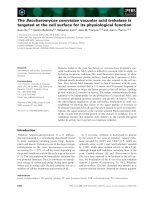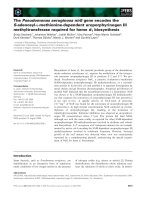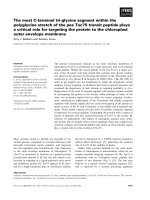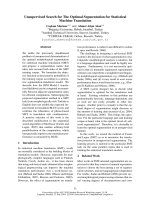Báo cáo khoa học: "The electrocardiogram for sepsis: how close are we" doc
Bạn đang xem bản rút gọn của tài liệu. Xem và tải ngay bản đầy đủ của tài liệu tại đây (32.85 KB, 2 trang )
Page 1 of 2
(page number not for citation purposes)
Available online />Abstract
In daily clinical practice the diagnosis of sepsis is imprecise and
often delayed. In part, this is because the diagnosis is based on a
clinical picture of signs and symptoms. This basis has significant
implications, as there is evidence that early events in sepsis may
determine outcome. A more objective set of measurements for
confirming the diagnosis of sepsis has long been sought. Several
sepsis biomarkers have been evaluated and shown to have a
moderate degree of sensitivity and specificity for diagnosing the
presence of bacterial infection. Efforts are now being directed
toward evaluating the utility of biomarker profiles, containing
multiple markers, for risk assessment and diagnosis in patients with
suspected sepsis.
A recent paper in Critical Care by Kofoed and colleagues [1]
is a good example of the promising new research in the field
of sepsis diagnosis. Physicians who face the challenge of
diagnosing sepsis, whether in the emergency department, on
the wards or in the intensive care unit, long for the day when
diagnosing this common and lethal illness will be similar to
identifying patients with myocardial ischemia – that we will
have at our disposal an objective set of measurements, such
as an electrocardiogram, enzymes and echocardiography.
Many of us are ‘jealous’ at the myriad of objective measure-
ments available to cardiologists when considering the
possibility of ischemia as a source of a given set of symptoms
for a patient. In the case of diagnosing sepsis, we have only a
nonspecific set of signs and symptoms and the suspicion of
infection to facilitate diagnosis. Many clinicians believe this is
the reason why clinical cardiology trials enroll larger numbers
of patients than trials in sepsis. It is not uncommon for a trial
evaluating a new agent for cardiac ischemia to have more
than 10,000 patents enrolled, while trials involved with
determining new therapeutic agents for sepsis struggle to
enroll 2,500 patients [2-5]. Over the past several years,
progress has been made towards making the diagnosis of
sepsis more objective. Several biomarkers have been
evaluated and shown to have a moderate degree of sensitivity
and specificity for diagnosing the presence of bacterial
infection [6]. In addition, recent data suggest that biomarkers
can also aid clinicians in risk assessment [7].
Why do we need more precise diagnosis and risk assess-
ment? In daily clinical practice the diagnosis of sepsis is
imprecise and often delayed [8]. This has significant
implications, as there is evidence that early events in sepsis
may determine outcome [9]. In addition, the degree of organ
dysfunction is correlated with increased mortality. Unfor-
tunately, predicting the development of organ dysfunction
and death remains uncertain. While biomarkers may facilitate
the diagnosis of sepsis, their real value may lie in the ability to
use biomarker profiles to assess risk in patients with sepsis.
Although challenging, the diagnosis of sepsis may not be as
significant as early risk assessment. Both are obviously
important, but in clinical practice the vast majority of patients
will receive empiric broad-spectrum antibiotics. Studies
suggest that early intervention is important for survival in
patients with severe sepsis and septic shock [10,11].
Accurate risk assessment, which might be used to guide the
intensity of therapeutic interventions, including intensive care
unit admission, may be more likely to have an impact on the
management, and ultimately the outcomes, of sepsis.
What do clinicians and clinical trials expect from an ‘ideal’
sepsis biomarker? Several characteristics come to mind: to
be highly sensitive and specific for sepsis, to allow the
differentiation between infectious and noninfectious causes
of inflammation, organ dysfunction and shock, to be present
at the onset or even before the appearance of the clinical
signs of sepsis, to have prognostic value, to indicate the
severity and the course of sepsis, and to be biologically
plausible. No single marker has been shown to possess such
qualities, but there are encouraging signs in the literature that
we are on the right path towards finding a marker or a set of
markers, which will facilitate diagnosis and risk assessment in
septic patients.
Commentary
The electrocardiogram for sepsis: how close are we?
Mitchell M Levy
Rhode Island Hospital/Brown University, 593 Eddy St, Providence, RI 02903, USA
Corresponding author: Mitchell M Levy,
Published: 26 June 2007 Critical Care 2007, 11:144 (doi:10.1186/cc5943)
This article is online at />© 2007 BioMed Central Ltd
See related research by Kofoed et al., />Page 2 of 2
(page number not for citation purposes)
Critical Care Vol 11 No 3 Levy
The study by Kofoed and colleagues [1] illustrates this new
trend in the evaluation of sepsis biomarkers. In this paper, the
authors test several markers individually for their ability to
discriminate bacterial versus nonbacterial causes of inflam-
mation, and then tested a composite three-marker and six-
marker test. In their study, the area under the curve was
greatest (0.88) for the six-marker test. There is a very
important message in this trial. Given the complexity of the
inflammatory response, identifying a single marker that might
precisely facilitate diagnosis and risk assessment is
unrealistic. It is therefore logical that effort is now being
directed toward evaluating the utility of biomarker profiles,
containing multiple markers, for risk assessment and
diagnosis in patients with suspected sepsis.
Several studies are now underway, utilizing biomarker profiles
as a means to identify patients who are likely to progress to
organ dysfunction. In the past, several markers, such as
interleukin-6 have been shown to be associated with mortality
in septic patients [12]. The question remains whether sepsis
biomarkers, identified from bench research, can be combined
into profiles that can be used to identify patients in the early
stages of sepsis who are likely to evolve organ dysfunction. In
this way, an ‘electrocardiogram of sepsis’ may finally become
a clinical reality. This kind of translational research has the
potential to transform the care of these septic patients and to
direct appropriate therapies to patients at risk early in the
disease process. Of course, many more trials involving large
populations of septic patients are needed before the
‘electrocardiogram of sepsis’ becomes a reality, but early
results from a trial such as that of Kofoed and colleagues
hold hope for all clinicians faced with the challenge of
predicting risk for patients with sepsis.
Competing interests
The author declares that they have no competing interests.
References
1. Kofoed K, Andersen O, Dronborg G, Tvede M, Petersen J, Eugen-
Olsen J, Larsen K: Use of plasma C-reactive protein, procalci-
tonin, neutrophils, macrophage migration inhibitory factor,
soluble urokinase p-type plasminogen activator receptor, and
soluble triggering receptor expressed on myeloid cells-1 in
combination to diagnose infections: a prospective study. Crit
Care 2007, 11:R38.
2. Opal S, Laterre PF, Abraham E, Francois B, Wittebole X, Lowry S,
Dhainaut JF, Warren B, Dugernier T, Lopez A, et al., Controlled
Mortality Trial of Platelet-Activating Factor Acetylhydrolase in
Severe Sepsis Investigators: Recombinant human platelet-acti-
vating factor acetylhydrolase for treatment of severe sepsis:
results of a phase III, multicenter, randomized, double-blind,
placebo-controlled, clinical trial. Crit Care Med 2004, 32:332-
341.
3. Abraham E, Reinhart K, Opal S, Demeyer I, Doig C, Rodriguez AL,
Beale R, Svoboda P, Laterre PF, Simon S, et al., OPTIMIST Trial
Study Group: Efficacy and safety of tifacogin (recombinant
tissue factor pathway inhibitor) in severe sepsis: a random-
ized controlled trial. JAMA 2003, 290:238-247.
4. Anonymous: Randomised trial of intravenous streptokinase,
oral aspirin, both, or neither among 17,187 cases of sus-
pected acute myocardial infarction: ISIS-2. ISIS-2 (Second
International Study of Infarct Survival) Collaborative Group
[see comment]. Lancet 1988, 2:349-360.
5. Anonymous: An international randomized trial comparing four
thrombolytic strategies for acute myocardial infarction. The
GUSTO investigators. N Engl J Med 1993, 329:673-682.
6. Uzzan B, Cohen R, Nicolas P, Cucherat M, Perret G: Procalci-
tonin as a diagnositic test for sepsis in critically ill adults and
after surgery or trauma: a systematic review and meta-analy-
sis. Crit Care Med 2006, 34:1996-2003.
7. Jensen J, Heslet L, Jensen T, Espersen K, Steffensen P, Tvede M:
Procalcitonin increase in early identification of critically ill
patients at high risk of mortality. Crit Care Med 2006, 34:
2596-2602.
8. Poeze M, Ramsay G, Gerlach H, Rubulotta F, Levy M: An interna-
tional sepsis survey: a study of doctors’ knowledge and per-
ception about sepsis [see comment]. Crit Care 2004, 8:
R409-R413.
9. Annane D, Sebille V, Charpentier C, Bollaert PE, Francois B,
Korach JM, Capellier G, Cohen Y, Azoulay E, Troche G, et al.:
Effect of treatment with low doses of hydrocortisone and flu-
drocortisone on mortality in patients with septic shock. JAMA
2002, 288:862-871.
10. Rivers E, Nguyen B, Havstad S, Ressler J, Muzzin A, Knoblich B,
Peterson E, Tomlanovich M, for the Early Goal-Directed Therapy
Collaborative Group: Early goal-directed therapy in the treat-
ment of severe sepsis and septic shock. N Engl J Med 2001,
345:1368-1377.
11. Levy MM, Macias WL, Vincent J-L, Russell JA, Silva E, Trzaskoma
B, Williams MD: Early changes in organ function predict even-
tual survival in severe sepsis. Crit Care Med 2005, 33:2194-
2201.
12. Steinmetz HT, Herbertz A, Bertram M, Diehl V: Increase in inter-
leukin-6 serum level preceding fever in granulocytopenia and
correlation with death from sepsis. J Infect Dis 1995, 171:225-
228.









